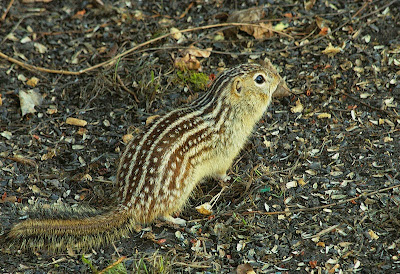Belongs within: Stichotrichina.
Anteholosticha is a genus of urostylid hypotrichs that have a continuous adoral zone, three enlarged frontal cirri and no caudal cirri; as the distinguishing characters of the genus are probably plesiomorphic for urostylids, its monophyly remains uncertain (Berger 2003).
Characters (from Berger 2003): Continuous adoral zone. Rearmost membranelles not wider than remaining membranelles of proximal portion. 3 enlarged frontal cirri. Buccal cirrus/cirri right of paroral. Frontoterminal cirri present. Midventral complex composed of midventral pairs only. Number of transverse cirri usually distinctly lower than number of midventral pairs. 1 left and 1 right marginal row. Anterior end of left marginal row ± straight, commences left of adoral zone. Caudal cirri lacking. Nuclear apparatus left of midline or scattered.
Anteholosticha Berger 2003 B03
|--*A. monilata (Kahl 1928) [=Holosticha monilata] B03
|--A. adami (Foissner 1982) [=Holosticha adami] B03
|--A. arenicola (Kahl 1932) [=Holosticha arenicola] B03
|--A. australis (Blatterer & Foissner 1988) [=Holosticha australis] B03
|--A. bergeri (Foissner 1987) [=Holosticha bergeri] B03
|--A. brachysticha (Foissner, Agatha & Berger 2002) [=Holosticha brachysticha] B03
|--A. brevis (Kahl 1932) [=Holosticha brevis] B03
|--A. camerounensis (Dragesco 1970) [=Holosticha camerounensis] B03
|--A. distyla (Buitkamp 1977) [=Holosticha distyla] B03
|--A. estuarii (Borror & Wicklow 1983) [=Holosticha estuarii] B03
|--A. extensa (Kahl 1932) [=Holosticha extensa] B03
|--A. fasciola (Kahl 1932) [=Holosticha fasciola] B03
|--A. gracilis (Kahl 1932) [=Holosticha gracilis] B03
|--A. grisea (Kahl 1932) [=Holosticha grisea] B03
|--A. manca (Kahl 1932) [=Holosticha manca] B03
|--A. mancoidea (Hemberger 1985) [=Holosticha mancoidea] B03
|--A. multistilata (Kahl 128) [=Holosticha multistilata] B03
|--A. muscicola (Gellért 1956) [=Holosticha muscicola] B03
|--A. muscorum (Kahl 1932) [=Holosticha muscorum] B03
|--A. oculata (Mereschkowsky 1877) [=Holosticha oculata] B03
|--A. pulchra (Kahl 1932) [=Holosticha pulchra] B03
|--A. randani (Grolière 1975) [=Holosticha randani] B03
|--A. scutellum (Fohn 1866) [=Holosticha scutellum] B03
|--A. sigmoidea (Foissner 1982) [=Holosticha sigmoidea] B03
|--A. sphagni (Grolière 1975) [=Holosticha sphagni] B03
|--A. thononensis (Dragesco 1966) [=Holosticha thononensis] B03
|--A. violacea (Kahl 1928) [=Holosticha violacea] B03
|--A. warreni (Song & Wilbert 1997) [=Holosticha warreni] B03
`--A. xanthichroma (Wirnsberger & Foissner 1987) [=Holosticha xanthichroma] B03
*Type species of generic name indicated
REFERENCES
[B03] Berger, H. 2003. Redefinition of Holosticha Wrzesniowski, 1877 (Ciliophora, Hypotricha). European Journal of Protistology 39 (4): 373-379.












